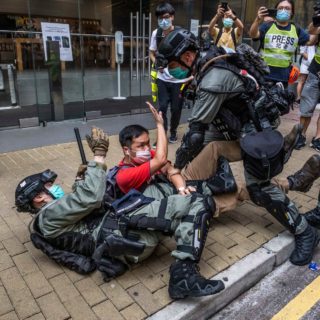
ODESSA — THE MOBILE PHONES began screeching just after 9am on October 11th in Taras Shevchenko park in Odessa. Ukraine’s state emergency service was warning of a “high probability of missile strikes”, advising citizens to get to bomb shelters and stay there. Many locals, inured to such alarms after seven months of war, continued to stroll along the park’s tree-lined promenades and enjoy its views of the Black Sea, though others headed for safety. By noon Ukraine’s armed forces said they had shot down three drones in the area. Meanwhile Russian missiles struck in Zaporizhia, Vinnitsa and Lviv, where the city’s mayor said they hit a dam and knocked out part of the electricity system. Twenty cruise missiles were shot down, according to officials.
It was the second consecutive day of large-scale Russian missile attacks on civilian neighbourhoods and infrastructure, though it was not nearly as serious as the first. On October 10th Russia launched 83 missiles at cities across Ukraine, killing at least 19 people. Ukraine said it had shot down 43 of those, but it still relies mainly on Soviet-era defence systems such as the Buk and the S-300, and its supplies of surface-to-air missiles are gradually being exhausted. (One video even showed a Ukrainian soldier shooting down a cruise missile with a shoulder-fired MANPAD anti-aircraft missile.) Modern integrated Western anti-aircraft and anti-missile systems are far more sophisticated, and Ukraine has been lobbying America and European countries for months to provide them. After the attacks Joe Biden spoke to Volodymyr Zelensky, Ukraine’s president, and promised that new systems were on the way. What sorts of air-defence kit might Ukraine receive, and why has it been slow in coming?
Early in the war, Mr Zelensky called on Israel to sell Ukraine its Iron Dome system. In fact, as Mr Zelensky eventually acknowledged, that system is not appropriate: it is designed to stop small short-range rockets such as those launched by Hamas, a Palestinian militant group, and can cover only a limited area. Russia is attacking Ukraine with long-range cruise missiles such as the Kalibr and Kh-101, which can skim at low altitudes to avoid radar. It is also using the Iskander ballistic missile and possibly the Kinzhal hypersonic cruise missile, both of which are far too large and fast for Iron Dome.
Instead, the first Western system to reach Ukraine’s arsenal will be Germany’s new IRIS-T. Ukraine is to get one battery, which consists of three lorry-mounted launchers carrying 24 missiles (eight per launcher) with ranges of 40km (25 miles), controlled by a separate command vehicle up to 20km away. The system’s radar is exceptionally sensitive and will be good at detecting low-flying, stealthy missiles such as the Kalibr, according to Denys Smazhnyi, the chief of training for Ukraine’s anti-aircraft missile forces.
By deploying numerous batteries, it would be possible to establish a defensive line up to 100km long, covering the main routes Russian missiles are using. Most importantly, the IRIS-T’s command vehicle integrates different sources of radar data from ground stations and aircraft into a single information space, so that a battery can engage targets even if it cannot yet see them. Soviet legacy systems such as the Buk and S-300 can only attack objects tracked by their own radar. And whereas those systems track and destroy targets one by one, an IRIS-T battery can launch and track all 24 of its missiles simultaneously, making it much harder to overwhelm with numbers.
A second system on its way is the Norwegian NASAMS. Like IRIS-T, it integrates multiple sources of data into one information space. It also uses a missile, the AMRAAM, which has been a standard NATO air-to-air combat missile for decades. Large existing stocks will make it easy to resupply. NASAMS is in service in 12 countries, including NATO members, and Ukrainian forces have already been trained to operate it. Its missiles have a 40km range, but a newer version will extend that to over 100km. When it comes into service, Ukraine may be able to use its improved missiles without having to replace the launch system.
Mr Biden did not make public which systems he had in mind. Ukraine has been lobbying since the spring for the foremost American air-defence missile, the Patriot. But “for now, we can only dream of getting this technology,” says Iurii Ignat, spokesman for Ukraine’s Air Force command. Each Patriot battery costs upwards of $1bn, and requires at least 70 soldiers with months of training to operate. And America does not have Patriot systems to spare, says Tom Karako of the Centre for Strategic and International Studies, a think-tank in Washington, DC: “These are the wages of de-emphasising air and cruise-missile defence for the past decade-plus.”
Mr Biden may simply have been referring to speeding up the already-pledged NASAMS. Germany first promised Ukraine the IRIS-T in June. It has been held up for technical reasons; Ukraine will have the first such system in operation, production intended for German forces having been diverted in its favour. The first arrived on October 11th.
When it does, Ukraine should be able to improve its rate of shooting down Russian cruise missiles, currently thought to be between 40-60%. Intercepting the ballistic Iskander, however, is beyond the capacities of the IRIS-T or the NASAMS. With a range of hundreds of kilometres, it tends to be already falling at very high speed towards its target when engaged by air defences. And it is too big for such systems to deflect very much: the IRIS-T’s entire missile weighs around 100kg, whereas the Iskander’s warhead alone can weigh 700kg. It is also capable of manoeuvring, which requires larger and more powerful interceptors to catch it. For the time being in Ukraine, according to Mr Smazhnyi, “the best protection against ballistic missiles is concrete.”




